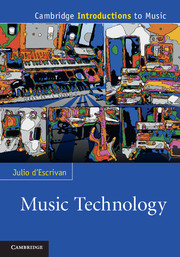Book contents
- Frontmatter
- Contents
- Preface
- Acknowledgements
- Figures
- Chapter 1 Representing and storing sound
- Chapter 2 A studio overview
- Chapter 3 Synthesisers, samplers and drum machines
- Chapter 4 Live music technology (the FAQs)
- Chapter 5 Select, remix, mashup
- Chapter 6 The producer
- Chapter 7 Music, sound and visual media
- Chapter 8 The studio as experimental lab
- Chapter 9 Controllers: new creative possibilities in performance
- Chapter 10 Hacking electronics for music
- Further avenues for exploration
- Notes
- Glossary
- Bibliography
- Index
Further avenues for exploration
Published online by Cambridge University Press: 05 June 2012
- Frontmatter
- Contents
- Preface
- Acknowledgements
- Figures
- Chapter 1 Representing and storing sound
- Chapter 2 A studio overview
- Chapter 3 Synthesisers, samplers and drum machines
- Chapter 4 Live music technology (the FAQs)
- Chapter 5 Select, remix, mashup
- Chapter 6 The producer
- Chapter 7 Music, sound and visual media
- Chapter 8 The studio as experimental lab
- Chapter 9 Controllers: new creative possibilities in performance
- Chapter 10 Hacking electronics for music
- Further avenues for exploration
- Notes
- Glossary
- Bibliography
- Index
Summary
Feeling adventurous?
I believe it is useful for a student to be aware of research relating to concepts explained in this book. The papers listed below are beyond the level of an introduction, but even if you just read their abstracts you will have an idea of what sorts of things you may be able to do in the future as a music technologist and what diverse areas can be covered. I have also included some ‘classics’ that are well worth a read even though technology may have moved on. Some of these papers are available for free on the internet by searching through sites like scholar.google.com; for others you may have to check the digital library or journal collections of your educational institutions. So, here are some suggestions:
Audio
If you are interested in the whole business of machine listening: ‘Musical Genre Classification of Audio Signals’ by George Tzanetakis and Perry Cook of the Computer Science Department of the University of Princeton. Published in the IEEE Transactions on Speech and Audio Processing, 10, 5 (2002), 293–302.
For academic sound engineers: ‘Engineering the Performance: Recording Engineers, Tacit Knowledge and the Art of Controlling Sound’ by Susan Schmidt Horning in Social Studies of Science, 34, 5, Special Issue on Sound Studies: New Technologies and Music (Oct. 2004), pp. 703–31.
If you want to check for the most detailed database of sound levels ever, go to: nhca.affiniscape.com/associations/10915/files/Noise%5FNav%2Exls.E. H. Berger, R. Neitzel and C. A. Kladden, 2008. ‘Noise Navigator® Sound Level Database with Over 1700 Measurement Values’. E•A•R / Aearo Company and Univ. of Washington, Dept. of Environmental and Occupational Health Sciences, Seattle, WA.
A historically important paper, since we always quote Nyquist when talking about sampling, is: H. Nyquist, ‘Certain Topics in Telegraph Transmission Theory’, trans. AIEE (American Institute of Electrical Engineers), 47 (April 1928), 617–44, from Proceedings of the IEEE, 90, 2 (2002). Available at: www.loe.ee.upatras.gr/Comes/Notes/Nyquist.pdf.
A great all-round book on audio technology with some down-to-earth introductions to aesthetics on audio technology and including a brief discussion of how semiotics relates to sound design is: Gary Gottlieb, Shaping Sound in the Studio and Beyond: Audio Aesthetics and Technology (Boston, MA: Thomson Course Technology PTR, 2007).
A great sampling primer: C. Roads and J. Strawn, The Computer Music Tutorial (Cambridge, MA, and London: MIT Press, 1996), 30–8.
- Type
- Chapter
- Information
- Music Technology , pp. 184 - 186Publisher: Cambridge University PressPrint publication year: 2011

